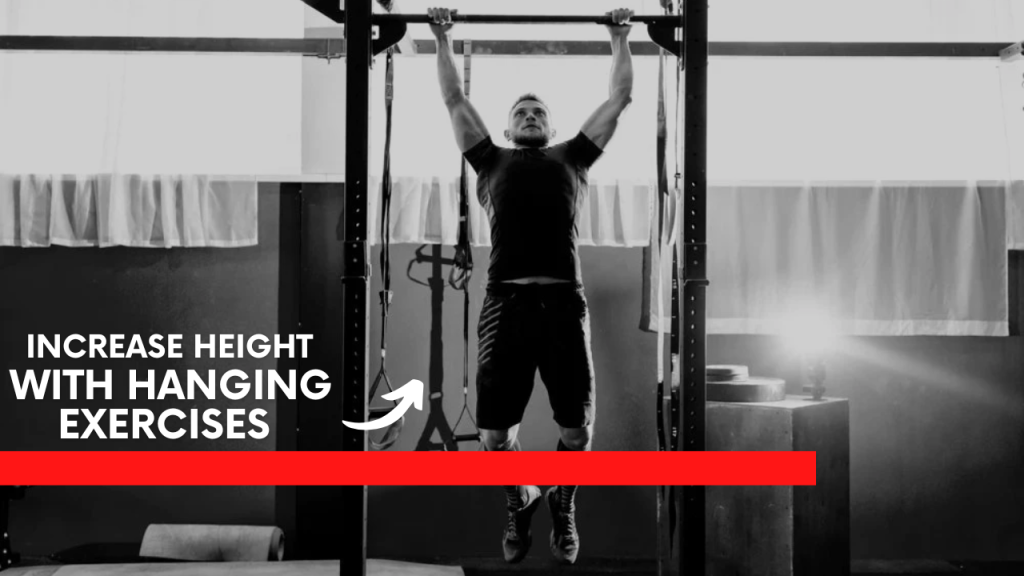Have you ever wished you could add just a few more inches to your height? What if the secret wasn’t in pills or genetics but in gravity itself? Welcome to the world of hanging exercises – one of the most natural, cost-free, and surprisingly effective ways to potentially enhance your posture and, in some cases, your height.
This post will explore the science, techniques, benefits, and precautions of hanging for height increase. While hanging won’t turn you into a basketball player overnight, it can be an incredibly beneficial addition to your daily routine if done right.

Table of Contents
Perks of Hanging Exercises for Height & Health
Spinal Decompression
– Relieves pressure on intervertebral discs caused by gravity
– Helps elongate the spine and restore natural height
Improves Posture
– Realigns the spine
– Strengthens postural muscles, reducing slouching and hunching
Enhances Flexibility
– Loosens tight back and shoulder muscles
– Improves spinal mobility and range of motion
Boosts Core Strength
– Engages abdominal and lower back muscles
– Supports better balance and posture over time
Increases Grip Strength
– Builds stronger forearms and hand muscles
– Improves overall functional strength
Reduces Back and Neck Pain
– Stretches out compressed areas
– Relieves tension from prolonged sitting or standing
Stimulates Growth Hormone Naturally
– Stretching and physical stress from hanging can aid in GH release (especially when combined with proper sleep and nutrition)
Improves Blood Circulation to the Spine
– Delivers nutrients to spinal discs
– Enhances recovery and regeneration
Boosts Overall Body Alignment
– Promotes symmetry and balance
– May help with leg length or shoulder imbalances caused by poor posture
Free, Natural & Equipment-Light
– Requires only a bar or stable overhead surface
– No need for supplements or expensive treatments
Do’s and Don’ts of Hanging Exercises
| Do’s | Don’ts |
|---|---|
| Warm up your shoulders and back before starting | Don’t hang from unstable or weak bars |
| Start with short durations (20–30 seconds) and gradually increase | Don’t overdo it in the beginning — avoid long hangs right away |
| Maintain a relaxed and steady body posture while hanging | Don’t swing your body or use jerky movements |
| Breathe deeply and stay calm during the exercise | Don’t hold your breath or strain excessively |
| Use chalk or gloves if your grip is weak | Don’t hang with sweaty or slippery hands (risk of slipping) |
| Incorporate core and flexibility exercises alongside hanging | Don’t rely on hanging alone for height improvement |
| Stop immediately if you feel pain or dizziness | Don’t ignore signs of discomfort or muscle fatigue |
| Consult a doctor if you have spine or joint issues | Don’t attempt advanced moves like weighted hanging too soon |
| Stay consistent — aim for daily or 3–4x weekly practice | Don’t expect overnight height changes — be patient |
What Can Happen After 30 Days of Hanging Exercises
| After 30 Days | What to Expect |
|---|---|
| Improved Posture | Noticeable reduction in slouching and rounded shoulders |
| Spinal Decompression | Relief from minor back stiffness and better spinal alignment |
| Height Regain | Potential gain of 0.5 to 2 inches (postural correction, not bone growth) |
| Stronger Grip | Enhanced hand and forearm strength, especially if done daily |
| Better Flexibility | Increased range of motion in shoulders and spine |
| Reduced Back Pain | Relief from tension caused by long hours of sitting or standing |
| Enhanced Core Stability | Stronger abs and back muscles from stabilization during hangs |
| Improved Confidence | Standing taller and feeling better physically can boost self-image |
| Greater Body Awareness | More control over posture and daily movement habits |
| Routine Discipline | Building consistency in fitness habits for long-term wellness |
Can Hanging Really Increase Height? The Science Behind It
Let’s be realistic: once your growth plates (epiphyseal plates) close after puberty, your bones no longer lengthen. However, there’s good news.
Most people lose 1–2 inches of height due to:
- Poor posture
- Spinal compression from gravity
- Muscle stiffness and spinal curvature
Hanging works by reversing spinal compression. Over time, the force of gravity compresses the cartilage in your spine, reducing your height subtly. Hanging elongates your spine by decompressing it, improving posture, and allowing you to stand taller.
Result? You may not grow “taller” in the genetic sense, but you’ll regain your natural maximum height.
Top Hanging Exercises to Improve Height Naturally
1. Passive Bar Hanging

- How to Do It: Grab a horizontal bar (chin-up bar or sturdy tree branch), let your body hang freely, arms extended.
- Duration: Start with 20–30 seconds; work up to 1–2 minutes, 2–3 sets daily.
- Benefits:
- Spinal decompression
- Shoulder mobility
- Improves grip strength
2. Hanging Leg Raises

- How to Do It: While hanging, lift both legs straight up (or knees to chest for beginners).
- Reps: 10–15 reps, 2–3 sets
- Benefits:
- Strengthens core
- Engages lower back
- Improves posture indirectly
3. Twisting Hanging

- How to Do It: While hanging, gently twist your torso from side to side.
- Duration: 30 seconds to 1 minute
- Benefits:
- Loosens up tight back muscles
- Improves spinal flexibility
- Enhances blood flow to the vertebrae
4. Weighted Hanging (Advanced)

- How to Do It: Add light ankle weights while hanging to increase traction.
- Caution: Only attempt under supervision or after mastering basic hanging.
- Benefits:
- Increased spinal traction
- Enhanced decompression
- Boosts strength and endurance
1-Week Hanging Exercise Plan
| Day | Exercise Name | Sets x Time/Reps | Focus Area | Notes |
|---|---|---|---|---|
| Day 1 | Dead Hang | 3 x 20–30 sec | Spinal decompression | Relax your body and breathe deeply |
| Knee Raises | 3 x 10 reps | Core & hip flexors | Engage abs, avoid swinging | |
| Day 2 | Pull-Up Hold (90°) | 3 x 10–20 sec | Upper back & arms | Hold it halfway up, and squeeze your shoulder blades |
| Straight Leg Raises | 3 x 8 reps | Core & lower abs | Keep legs straight, controlled motion | |
| Day 3 | Passive Hang | 4 x 30 sec | Spinal traction | Let your shoulders fully relax |
| Side-to-Side Sway | 3 x 15 sec each side | Lats & side body | Gently sway side to side | |
| Day 4 | Rest or Light Stretching | — | Recovery | Include shoulder rolls and cat-cow stretches |
| Day 5 | Active Hang | 3 x 20–30 sec | Shoulder engagement & posture | Slightly pull shoulder blades down & back |
| Hanging Torso Twists | 2 x 10 twists | Obliques & spine mobility | Twist gently from the waist | |
| Day 6 | Dead Hang + Weighted (optional) | 3 x 20 sec | Advanced spinal decompression | Use light ankle weights or backpack |
| Hanging Bicycles | 2 x 12 reps each leg | Core & coordination | Controlled motion, avoid swinging | |
| Day 7 | Dead Hang | 2 x 30–40 sec | Full-body reset | Controlled motion; avoid swinging |
Tips for Best Results:
- Do a light warm-up before starting (arm swings, shoulder rolls).
- Focus on form over duration.
- Track your daily performance (time held, reps, posture).
- Stay hydrated and complement your routine with stretching and good sleep.
Complementary Tips for Better Results
To make the most of your hanging routine, combine it with:
Stretching & Yoga
- Incorporate spine-lengthening stretches like the Cobra Pose, Cat-Cow, and Downward Dog.
Posture Training
- Focus on exercises that strengthen your back, core, and shoulders.
- Practice standing tall with your chin up and shoulders back.
Proper Nutrition
- Eat a diet rich in calcium, protein, vitamin D, and magnesium to support bone health.
- Stay hydrated to keep spinal discs plump and healthy.
Quality Sleep
- The growth hormone is released during deep sleep. Ensure 7–9 hours of rest.
- Sleep on a firm mattress with proper spinal alignment.
How Long Until You See Results?
Expect gradual improvements over 3 to 6 weeks. Consistency is key.
- You may regain up to 1.5 inches in posture-based height.
- Increased flexibility, strength, and a taller stance are often visible in a month.
Common Myths About Hanging for Height
- “Hanging will make you permanently taller.”
Not true. It corrects posture-related compression, not bone growth. - “You need to hang for hours daily.”
Even just 5–10 minutes a day can offer noticeable improvements. - “Only teens can benefit from this.”
Adults of any age can improve spinal health and posture through hanging.
Precautions Before You Start
- Warm up your shoulders and back to avoid strain.
- If you have any spine or joint issues, consult a doctor first.
- Avoid jerky movements; maintain a controlled hang.
- Use a strong, secure bar to prevent injury.
Final Thoughts: Hang In There for a Healthier, Taller You
While hanging exercises may not rewrite your genetic code, they can help you unlock your true height potential by decompressing your spine, improving posture, and building core strength.
Think of it as gravity’s reset button—one that’s free, simple, and effective. Whether you’re looking to stand taller, reduce back pain, or just stretch out after a long day, hanging might just be your new favorite health habit.
Frequently Asked Questions (FAQs)
Can hanging exercises actually make you taller?
Hanging exercises won’t make your bones grow longer, especially after puberty. However, they can decompress your spine, improve posture, and restore up to 1–2 inches of your natural height that may have been lost due to poor posture or spinal compression.
How long should I hang daily to see results?
Start with 2–3 sets of 20–30 seconds each per day and gradually increase to 1–2 minutes per set. Consistency over several weeks is key to seeing posture-related height improvements.
Is it safe to hang every day?
Yes, hanging daily is generally safe for healthy individuals. It’s a low-impact exercise. Just ensure you warm up first, use proper form, and don’t overdo it—especially if you’re new to it or have shoulder or back issues.
Who should avoid hanging exercises?
People with conditions like herniated discs, severe scoliosis, shoulder injuries, or vertigo should consult a healthcare provider before starting any hanging exercises.
At what age is hanging most effective for height gain?
Hanging can benefit anyone at any age by improving posture and spinal health. However, those under 18 may experience more significant results if their growth plates are still open.
Can I do hanging exercises at home?
Absolutely! A pull-up bar installed in a doorway or a sturdy horizontal bar can work perfectly. Just make sure it’s well-secured to avoid accidents.
Does adding weights to hanging help increase height faster?
Weighted hanging increases spinal traction, but it should only be attempted by those experienced with bodyweight training. It doesn’t necessarily speed up height gain, but it can intensify spinal decompression.
Are there other benefits to hanging besides height improvement?
Yes! Hanging can strengthen your grip, relieve back pain, improve shoulder mobility, decompress your spine, and even reduce stress. It’s a full-body wellness practice.





